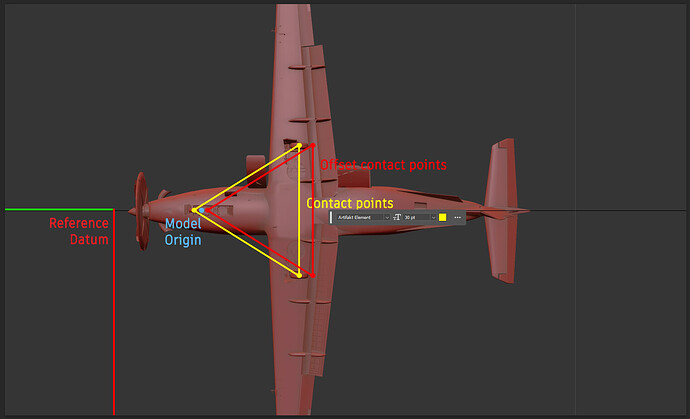@FlyingRaccoon I would like to report a severe bug in the ground handling. The bug can be fixed, or documentation updated to help developers avoid the issue.
Here is what is happening. On this image you see:
- Reference datum point: in the aircraft manual it is measured off of where the forward cockpit firewall is.
- 3D model origin (pale blue). We put it where the forward cockpit firewall is
- Contact points (yellow). We matched them to our landing gear
In numbers:
- The firewall is at 0
- The datum is 9.833ft forward
- The nose gear is -9.604ft from the datum, which makes it 0.229ft forward of the origin
With this setup, the plane’s turn radius is wrong and the main gears are skidding sideways during a turn. The orange triangle gives an approximation of where the wheels feel to be for that kind of behaviour.
I tried fixing it by moving the contact points 0.5ft further aft to see how it affects handling. In the next image you can see the new contact point setup in red (slightly exaggerated).
To my surprise the plane started turning opposite to the rudder input when on the ground. Right rudder would give left turns and vice versa! It is as if right rudder would push the tail to the right, and thus the nose to the left!
This led me to the conclusion that ground handling does not use the contact points to calculate a turn radius, but instead tries to turn the model around the 3D model origin. The last image shows how a left rudder input would make the plane’s nose turn right and it is exactly what I experienced.
A very similar bug affected the center of Gravity calculation and was fixed at Sim Update 4. I would like to ask that this bug is either fixed, or clearly documented in the SDK that developers should center their 3D model on the main gears to avoid this kind of issue.
We have been working on this aicraft for 16 months and having to shift the origin & datum could have unforeseen implications in a year’s worth of flight modelling if this bug affects other things as well.
4 Likes
Hello @SWSAlexVletsas !
May I ask you to send us your package to let us investigate on this issue? You can follow the third point of this page to do so.
Thanks,
Alexandre
Hello @GentleLynx ,
Do you want the PackageSources or a community pack?
Best,
Alex
Hello @SWS-AlexVletsas
We were able to reproduce the issue you reported here.
Rudder input being inverted comes from the fact your aircraft is considered a tail dragger when the center wheel is placed behind the model origin.
I also reproduced the issue with the aircraft rotation on ground being off.
I have no clear explanations yet but model origin seems to play a role here as well.
I’ll have this investigated.
In the meantime, I’d say having the model origin, ref datum and CG defined close to each other is recommended.
@Nocturne for documentation
Regards,
Sylvain
2 Likes
This posting is a bit late.
The guidance for the correct VMO is located here in the SDK…
FLIGHT MODEL PHYSICS>
Referential Frames And Conventions>
Aircraft Body Frame>
This frame is attached to the aircraft body. According to historical FSX conventions inherited by Microsoft Flight Simulator it is centered on the centerline chord aft of the leading edge.
The point in the model is the visual center when loaded into Microsoft Flight Simulator. The term “centerline chord” is the ¼ root chord. This is usually the exact same point in the model. By default Microsoft Flight Simulator defines the center of lift as the model’s center, which means the center of lift is (by default) defined at the ¼ root chord position.
Be careful, this is only true if the modeler did in fact set the model’s mesh origin to the ¼ root chord position! If the modeler chose for some reason to set the model’s origin at the tip of the aircraft nose, then all bets are off on the model ever being able to be properly configured…
1 Like
I noticed this late, but it is indeed there. The good news is that this only affects ground handling, flight is fine.
The problem is that ground handling is hardcoded around the VMO and doesn’t take into account the main wheels for turn radius; it is nose wheel and VMO that define the turn centre and radius. This leads to skating problems when in contact with the ground and water which can be masked in most cases, but not all.


